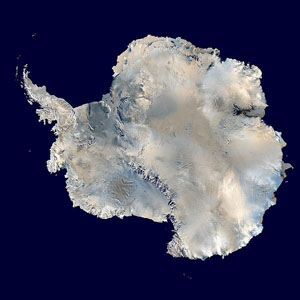Today, we are concerned with global warming, melting ice-sheets, and the subsequent rise in sea levels. However, 35 million years ago, Antarctica was suddenly, in geological terms, covered in ice for the first time in 100 million years. Until that time, the continent had been essentially ice-free.
Until now, scientists could have safely assumed that falling levels of atmospheric carbon dioxide were the driving force behind the temperature drop that could freeze the continent. However, a new study provides evidence of a correlation scientists previously lacked.

Matthew Huber
The researchers point out that no evidence of global cooling during this freezing period has been found. Previous evidence points paradoxically to a stable climate at the same time this event, one of the biggest climate events in Earth’s history, was happening, Huber explains.
Now, Matthew Huber of Purdue University, Indiana and his colleagues Robert DeConto and Mark Leckie of the University of Massachusetts, Mark Pagani, Zhonghui Liu, and David Zinniker at Yale University in New Haven, Connecticut, and Henk Brinkhuis of Utrecht University, Netherlands, and Sunita R. Shah and Ann Pearson of Harvard University, report the results of a computer modelling study spanning 8000 years of data (50 terabytes). Their results suggest that there was widespread cooling and that a reduction in atmospheric levels of greenhouse gases was to blame.

Satellite composite image of Antarctica (Credit: Dave Page)
Long after the dinosaurs went extinct the Earth basked in balmy temperatures around 25 Celsius even at the Poles, which during that time had a climate akin to today’s sub-tropical regions. But almost overnight temperatures plummeted. Antarctica was covered in ice and sea levels fell. Many species of mammals as well as most reptiles and amphibians became extinct.
Our studies show that just over thirty-five million years ago, ‘poof,’ there was an ice sheet where there had been subtropical temperatures before, Huber says. Until now we haven’t had much scientific information about what happened.
The research team determined the temperatures of the Earth millions of years ago by using temperature proxies, or clues. In this case, the geologic detectives looked for the presence of biochemical molecules, which were present in plankton that only lived at certain temperatures. The researchers looked for the temperature proxies in seabed cores collected by drilling in deep-ocean sediments and crusts from around the world.
The researchers have thus established a link between the sea surface temperatures and the glaciation of Antarctica. This correlates with temperature data and existing proxy records that indicate a sharp drop in atmospheric carbon dioxide levels at this time, the Eocene-Oligocene boundary.
Further reading
Science, 2009, 323, 1187-1190
http://dx.doi.org/10.1126/science.1166368
Matthew Huber homepage
http://web.ics.purdue.edu/~huberm/
Suggested searches
glaciation
Antarctic
ice